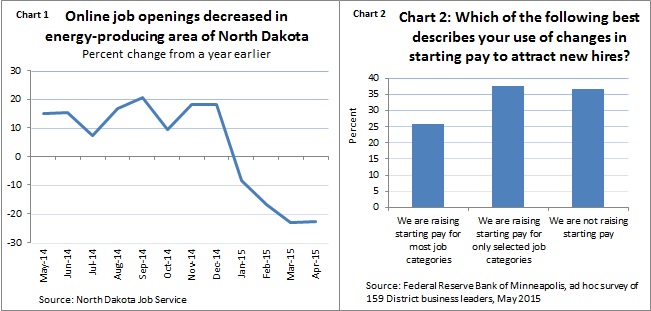Since early April, some key sectors in the Ninth District economy have varied, but overall growth has been moderate. Home sales and prices increased at a strong rate, although residential construction remained flat. Energy and mining activity continued to decline, contributing to a slowdown in spending and employment in the energy-producing region of western North Dakota and eastern Montana. While prices were relatively stable and wage increases remained mild, some signs of increased wage pressures appeared.
Residential real estate and consumer spending grew
Residential real estate activity showed strong increases in many parts of the Ninth District during April compared with a year earlier. For example, in western Wisconsin, home sales increased 25 percent and the median sales price rose 12 percent, while in Minnesota, home sales were up 20 percent with the median sales price up 12 percent. Home sales were buoyed in part by a relatively mild spring in many parts of the district. Meanwhile, residential construction was flat overall.
Retail and tourism spending also contributed to positive economic growth. According to a recent survey of district business leaders conducted by the Minneapolis Fed, 40 percent of respondents noted that retail spending increased over the past three months, while 12 percent reported that sales had decreased. An auto dealers association expects Minnesota vehicle sales in 2015 to exceed last year’s levels. Tourism activity was solid in many parts of the district in part due to seasonably warm weather. A travel agency in Minnesota noted that leisure travel bookings for March and April were up over 10 percent.
Meanwhile, manufacturing activity was level overall in April and May. The impact of the recent increase in the exchange value of the dollar likely had an effect on district manufacturers, as 29 percent of manufacturer respondents to the district business-leader survey reported that the dollar’s rise had decreased sales, though most reported that sales had not changed. “Increased value of the dollar has hurt our bottom line because of lower revenue from outside the U.S. on same volume,” commented a respondent. An index of manufacturing activity by Creighton University increased in April from the previous month in Minnesota and South Dakota; the index fell in North Dakota, but was at levels consistent with slight growth in all three states.
Natural resources sectors were slow
Natural resources sectors, including agriculture, energy and mining, had a depressing effect on the district economy. While progress in crop planting was well ahead of its five-year average and drought conditions were relieved by recent rains in several areas, the Minneapolis Fed’s first-quarter (April) survey of agricultural credit conditions showed that 79 percent of respondents said farm incomes fell in the previous three months, with a similar outlook for the second quarter. The avian flu has impacted a number of poultry producers and is expected to cost Minnesota turkey producers more than $300 million.
In the energy-producing area of the district, the drilling rig count dropped to 79 in mid-May, all in North Dakota (no rigs were active in Montana), down from almost 200 in September 2014. The continued decline in drilling activity led to layoffs of oilfield workers and reduced demand for support services. Nevertheless, oil production levels and transportation remained relatively high, albeit down from record levels set in December. The slowdown in oil drilling made its way to Wisconsin and Minnesota, where output at mines producing sand for hydraulic fracturing was expected to decline this year and one facility was idled. However, the overall economic impact of the reduction in oil and gas drilling has remained relatively contained to the energy-producing area.
Some tightening in labor markets and signs of wage pressures
As the district continued to show signs of moderate economic growth, hiring increased on balance and labor markets tightened further. According to a recent ad hoc survey by the Minneapolis Fed, 40 percent of respondents said their ability to retain employees has become harder over the past 12 months, while just 3 percent said it has become easier. “We are seeing a lot of employee turnover, as most see this as the best way to impact salary and opportunity,” noted a respondent to the professional business services survey. A Minnesota manufacturers survey found that hiring plans for the upcoming year are similar to a year ago. However, labor markets softened in the energy-producing area of the district; online job openings were down 23 percent in April compared with a year earlier in the North Dakota oil patch (see Chart 1).
Prices were relatively stable, except for a recent increase in gasoline prices. Wage increases remained mild in April and May, with some instances of increased wage pressures. For example, about a quarter of respondents to the aforementioned ad hoc survey were raising starting pay for most job categories to attract new hires (see Chart 2). Three health care systems in Minnesota have agreed to a minimum wage of $15 per hour under recent contract agreements.






